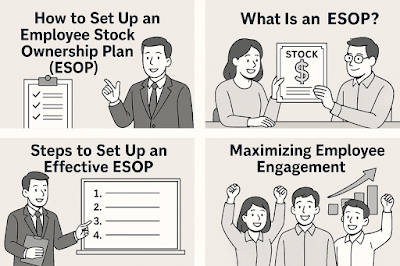How to Set Up an Effective Employee Stock Ownership Plan (ESOP)
How to Set Up an Effective Employee Stock Ownership Plan (ESOP)
Employee Stock Ownership Plans, or ESOPs, have become a powerful way for companies to align employees' interests with the company’s long-term success.
In this guide, we'll walk you through the key steps to set up an ESOP effectively, especially for small to mid-sized businesses in the U.S.
We’ll also explore the tax advantages, compliance requirements, and ways to maximize employee engagement through ownership.
📌 Table of Contents
- What Is an ESOP?
- Why Set Up an ESOP: Key Benefits
- Steps to Set Up an Effective ESOP
- Compliance and Regulatory Considerations
- Maximizing Employee Engagement
- Useful External Resources
📘 What Is an ESOP?
An Employee Stock Ownership Plan (ESOP) is a qualified retirement plan that invests primarily in the stock of the sponsoring employer.
It allows employees to become beneficial owners of the company while enjoying certain tax advantages.
Unlike traditional stock options, ESOPs are trust-based and federally regulated under the Employee Retirement Income Security Act (ERISA).
🌟 Why Set Up an ESOP: Key Benefits
One major reason companies implement ESOPs is to create a succession strategy, especially for founders approaching retirement.
ESOPs also offer tremendous tax advantages. For example, owners selling to an ESOP can defer capital gains taxes under Section 1042 of the Internal Revenue Code.
Employees benefit too—receiving shares without investing personal funds, which can enhance their retirement savings.
And let’s not overlook the cultural impact: ESOP companies often report stronger employee loyalty, productivity, and retention.
🛠️ Steps to Set Up an Effective ESOP
1. Feasibility Study: Determine if your business is financially healthy enough to support an ESOP structure.
This includes evaluating cash flow, payroll capacity, and long-term growth plans.
2. Hire an ESOP Advisor: Work with financial advisors, valuation firms, and attorneys experienced in ESOP design and execution.
3. Company Valuation: Have a third-party expert perform a fair market valuation of your company to determine how much the ESOP will pay.
4. Structure the ESOP Trust: Set up a tax-qualified ESOP trust to hold the company shares on behalf of employees.
5. Obtain Financing (if needed): Many ESOPs are leveraged, meaning the company borrows money to buy out the owner's shares.
6. Implement and Communicate: Educate employees about what ownership means and how it works to foster buy-in and excitement.
📝 Compliance and Regulatory Considerations
ESOPs must comply with a wide range of federal regulations, including those enforced by the Department of Labor (DOL) and IRS.
Regular appraisals of company stock are required, and annual filings such as Form 5500 must be submitted.
Failing to meet fiduciary responsibilities could result in legal penalties, so hiring a plan administrator or fiduciary is often a smart move.
🤝 Maximizing Employee Engagement
Merely giving stock isn’t enough—employees need to understand the value of their stake.
Offer regular education sessions, updates on company performance, and dashboards to help them see their equity grow over time.
Some companies tie bonuses or promotions to share value appreciation, further incentivizing high performance.
🔗 Useful External Resources
To dive deeper into ESOP strategies and regulations, check out these trusted resources:
Setting up an ESOP isn’t just a financial strategy—it’s a cultural shift that builds long-term resilience and loyalty.
If done right, it can become a legacy move for founders and a life-changing benefit for employees.
It’s not just ownership. It’s empowerment.
Start with research, consult experts, and tailor your plan to your workforce’s unique needs and your company's goals.
Want help breaking down your ESOP design? Bookmark this post and share it with your HR or finance team.
Every strong company starts with strong ownership—and now, it can be in your employees’ hands too.
Keywords: ESOP, employee ownership, retirement plan, tax benefits, business succession
